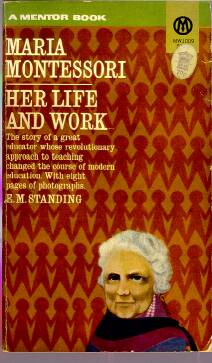

 |
STANDING E.M. MARIA MONTESSORI her life and work The story of a great educator whose revolutionary approach to teaching changed the course of modern education.
NEW AMERICAN LIBRARY |
Revolution in the Classroom
The inspired educational ideas of Maria Montessori have taken root all over the world in
Europe, America, Russia, India, China, Japan. Through the Montessori method even the
physical aspects of elementary schoolrooms have changed from dull regimentation to
colorful informality.
Maria Montessori’s first observations came from an Italian classroom of retarded
children; she found that even these unfortunates, when encouraged, had a spontaneous
interest in learning, and a spontaneous self-discipline. Applying her discovery to normal
children, allowing her students to progress in an atmosphere of freedom, Dr. Montessori
found that they paced their own development through a series of sensitive periods where
they became acutely aware of language, order, their own senses, society. Her method
encouraged these periods to explode into bursts of creativity – reading, writing,
passionate curiosity – thereby freeing the mind of even the apparent dullard and
giving new scope to education and new breadth to the mind and spirit of the child.
In this fascinating biography, written by her friend and disciple E. M. Standing, Dr.
Montessori emerges by indirection – in quotations from her letters and diaries which
reveal her humility and her delight with the success of her experiments – as an
engagingly warm and self-forgetful person. Rounding out the portrait are eight pages of
photographs of Montessori children at work in many countries of the world.
Contents
AUTHOR’S NOTE
INTRODUCTION BY JOHN J. MCDERMOTT
AUTHOR’S PREFACE
LIFE OF DR. MARIA MONTESSORI
Preparation
Discovery
Development
A Great and "Representative" Personality
THE PSYCHOLOGY OF DEVELOPMENT
The Young Explorer
Stages of Development
"Sensitive Periods" in Development
The "Work" of the Child - The Creation of the Adult
The Sensorial Foundations of Intellectual Life
Deviations and Normality
THE SIGNIFICANCE OF MOVEMENT IN EDUCATION
A Visit to Lilliput
Movement in Relation to Instinct and Reason
The Exercises of Practical Life
Movement and Mental Assimilation
THE NEW RELATIONSHIP
The Fundamental Problem in Education
The Prepared Environment
Liberty in Education - True and False
The Montessori Directress
MONTESSORI AND FROEBEL
Similarities
Differences
Montessori, Froebel, and the Junior School
THE MONTESSORI METHOD
The name Montessori ranks with that of Dewey among today’s educators. In a lifetime
devoted to improving the education of children, this dedicated woman discovered the
hitherto unknown fact that every child has a spontaneous urge to learn. She evolved a new
method that revolutionized teaching concepts, freed the child from the rigid disciplines
of ’," formal education, and brought to the classroom a sense of joy and
self-achievement.
"A monumental synthesis of the ideas of a great woman-doctor, educator and
humanitarian." - AVE MARIA
"A book of world-wide importance." - BRITISH BOOK NEWS
E. MORTIMER STANDING was born of Quaker missionaries in Madagascar in 1887 and was
educated in England in Quaker schools and at Cambridge University. A student of philosophy
and a teacher of wide experience, he became a Catholic in 1923. Mr. Standing first met
Maria Montessori in 1921, and for the next thirty years worked in close collaboration with
her. This book was written in response to her urging that he prepare a systematic
presentation of her principles and practice.